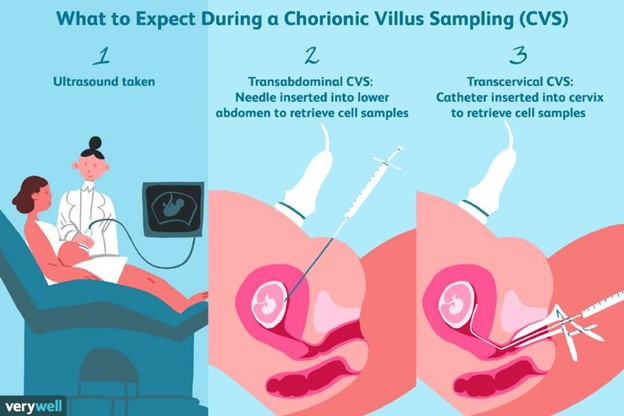A nurse is planning care for a client following a chorionic villus sampling.
The nurse should recognize that the client is at risk for developing which of the following complications?
Anemia
Infection
Late decelerations
Placental insufficiency.
The Correct Answer is B
Chorionic villus sampling (CVS) is a prenatal test that involves taking a sample of tissue from the placenta to test for chromosomal abnormalities and certain other genetic problems.
As with all types of surgical procedures, infections can happen during or after CVS2.

Choice A is incorrect because anemia is not a known complication of CVS.
Choice C is incorrect because late decelerations are a type of fetal heart rate patern that can occur during labor and are not related to CVS.
Choice D is incorrect because placental insufficiency is a condition where the placenta is unable to provide enough oxygen and nutrients to the fetus and is not a known complication of CVS.
Nursing Test Bank
Naxlex Comprehensive Predictor Exams
Related Questions
Correct Answer is ["A","E"]
Explanation
The nurse should plan to immunize the client with the inactivated influenza vaccine (A) and the diphtheria-acellular pertussis vaccine (E).

The Centers for Disease Control and Prevention (CDC) recommends that pregnant women get two vaccines during every pregnancy: the inactivated flu vaccine and the Tdap vaccine.
The other vaccines listed are not recommended during pregnancy:
- The human papillomavirus vaccine is not recommended during pregnancy.
- The varicella vaccine is not recommended during pregnancy.
- The measles, mumps, and rubella vaccine is not recommended during pregnancy.
Correct Answer is A
Explanation
Thrombocytopenia is defined as a platelet count of less than 150,000/microL1.
Severe neonatal thrombocytopenia (platelet count <50,000/microL) can be associated with bleeding and potentially significant morbidity.
As a result, it is important to identify at-risk neonates and report low platelet counts to the provider.
Choice B is incorrect because a hematocrit of 48% is within the normal range for a newborn.
Choice C is incorrect because a blood glucose level of 58 mg/dl is within the normal range for a newborn.
Choice D is incorrect because a hemoglobin level of 16 g/dL is within the normal range for a newborn.
Whether you are a student looking to ace your exams or a practicing nurse seeking to enhance your expertise , our nursing education contents will empower you with the confidence and competence to make a difference in the lives of patients and become a respected leader in the healthcare field.
Visit Naxlex, invest in your future and unlock endless possibilities with our unparalleled nursing education contents today
Report Wrong Answer on the Current Question
Do you disagree with the answer? If yes, what is your expected answer? Explain.
Kindly be descriptive with the issue you are facing.
